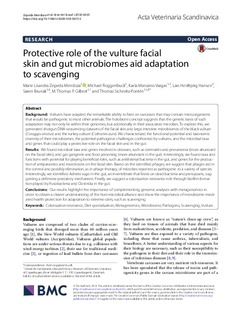| dc.contributor.author | Zepeda Mendoza, M. Lisandra | |
| dc.contributor.author | Roggenbuck, Michael | |
| dc.contributor.author | Manzano Vargas, Karla | |
| dc.contributor.author | Hestbjerg Hansen, Lars | |
| dc.contributor.author | Brunak, Søren | |
| dc.contributor.author | Gilbert, Marcus Thomas Pius | |
| dc.contributor.author | Sicheritz-Ponten, Thomas | |
| dc.date.accessioned | 2019-09-19T07:29:21Z | |
| dc.date.available | 2019-09-19T07:29:21Z | |
| dc.date.created | 2019-01-30T09:16:13Z | |
| dc.date.issued | 2018 | |
| dc.identifier.citation | Acta Veterinaria Scandinavica. 2018, 60 1-19. | nb_NO |
| dc.identifier.issn | 1751-0147 | |
| dc.identifier.uri | http://hdl.handle.net/11250/2617531 | |
| dc.description.abstract | Background
Vultures have adapted the remarkable ability to feed on carcasses that may contain microorganisms that would be pathogenic to most other animals. The holobiont concept suggests that the genetic basis of such adaptation may not only lie within their genomes, but additionally in their associated microbes. To explore this, we generated shotgun DNA sequencing datasets of the facial skin and large intestine microbiomes of the black vulture (Coragyps atratus) and the turkey vulture (Cathartes aura). We characterized the functional potential and taxonomic diversity of their microbiomes, the potential pathogenic challenges confronted by vultures, and the microbial taxa and genes that could play a protective role on the facial skin and in the gut.
Results
We found microbial taxa and genes involved in diseases, such as dermatitis and pneumonia (more abundant on the facial skin), and gas gangrene and food poisoning (more abundant in the gut). Interestingly, we found taxa and functions with potential for playing beneficial roles, such as antilisterial bacteria in the gut, and genes for the production of antiparasitics and insecticides on the facial skin. Based on the identified phages, we suggest that phages aid in the control and possibly elimination, as in phage therapy, of microbes reported as pathogenic to a variety of species. Interestingly, we identified Adineta vaga in the gut, an invertebrate that feeds on dead bacteria and protozoans, suggesting a defensive predatory mechanism. Finally, we suggest a colonization resistance role through biofilm formation played by Fusobacteria and Clostridia in the gut.
Conclusions
Our results highlight the importance of complementing genomic analyses with metagenomics in order to obtain a clearer understanding of the host-microbial alliance and show the importance of microbiome-mediated health protection for adaptation to extreme diets, such as scavenging. | nb_NO |
| dc.language.iso | eng | nb_NO |
| dc.publisher | BMC Springer Nature | nb_NO |
| dc.rights | Navngivelse 4.0 Internasjonal | * |
| dc.rights.uri | http://creativecommons.org/licenses/by/4.0/deed.no | * |
| dc.title | Protective role of the vulture facial skin and gut microbiomes aid adaptation to scavenging | nb_NO |
| dc.type | Journal article | nb_NO |
| dc.type | Peer reviewed | nb_NO |
| dc.description.version | publishedVersion | nb_NO |
| dc.source.pagenumber | 1-19 | nb_NO |
| dc.source.volume | 60 | nb_NO |
| dc.source.journal | Acta Veterinaria Scandinavica | nb_NO |
| dc.identifier.doi | 10.1186/s13028-018-0415-3 | |
| dc.identifier.cristin | 1668262 | |
| dc.description.localcode | Open Access This article is distributed under the terms of the Creative Commons Attribution 4.0 International License (http://creativecommons.org/licenses/by/4.0/), which permits unrestricted use, distribution, and reproduction in any medium, provided you give appropriate credit to the original author(s) and the source, provide a link to the Creative Commons license, and indicate if changes were made. | nb_NO |
| cristin.unitcode | 194,31,10,0 | |
| cristin.unitname | Institutt for naturhistorie | |
| cristin.ispublished | true | |
| cristin.fulltext | original | |
| cristin.qualitycode | 1 | |

